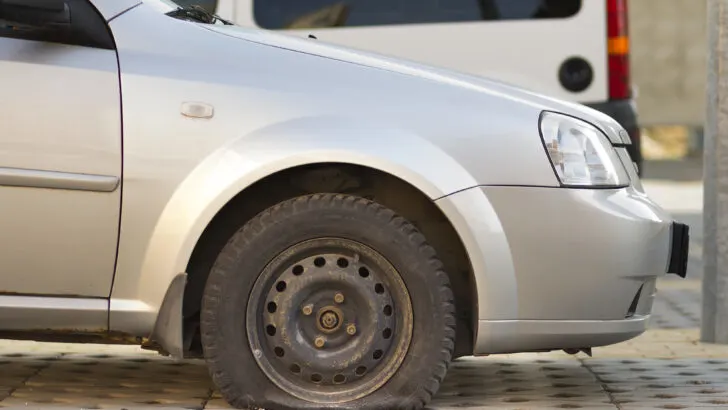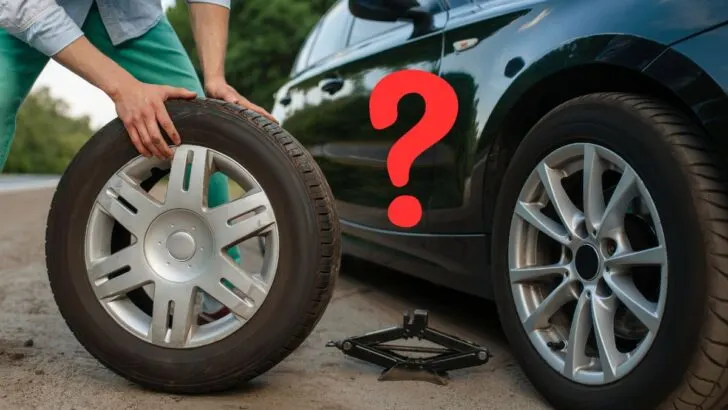Got a flat tire and relying on a spare? If you’re wondering how fast you can drive on a spare tire without compromising your safety, then you’re in the right place!
The speed at which you can drive on a spare tire can vary depending on the manufacturer’s recommendations and the specific type of spare tire. In general, it is advisable to drive at a reduced speed, typically around 50 miles per hour or lower, and to limit your driving distance to the nearest repair facility or tire shop to replace the spare tire with a regular one as soon as possible.
In this article, I’ll dive into the common questions surrounding spare tires and provide you with the essential knowledge to navigate the road with confidence during unexpected tire emergencies.
Table of Contents
Different Types of Spare Tires
There are normally three types of tires you can use to replace your tire in case of a flat.
Each of the three will have its own set of pros and cons, but they all share the same purpose – to get you back home or over to a mechanic’s garage to get your flat tire properly repaired!
Option 1: The Donut
Sometimes called a dummy tire, the donut is the most common spare tire you will see on smaller-sized vehicles.
This tire is normally undersized and much more narrow than your standard tire and can be funny to look at.
The reason the donut is so small is so it can fit into the trunk of a smaller car.
Since space is normally limited in these small vehicles, a full-size extra tire will take up a lot of room and add considerable weight to the vehicle.
Option 2: Full Size Spare
In larger SUVs and larger trucks, having an extra full-size tire is more common.
These vehicles wouldn’t be very well balanced with a smaller donut as their spare, so in order to be safe on the road for the short trip to the repair shop.
In many cases, your full-size spare can be used as a permanent replacement in the event of a flat tire.
However, you should still visit a mechanic afterward in order to have all of the lug nuts tightened to ensure the replacement tire stays on the vehicle when driving at normal highway speeds.
Option 3: Run Flats
Some vehicles are equipped with run flat tires. These tires look relatively normal but can be slightly thinner than standard tires on other vehicles.
The purpose of a run flat tire is to still be able to be used in the event of a puncture from a nail or screw.
Run flats can get you to a repair shop or mechanic within a short distance before they are completely torn apart and too damaged to drive on any longer.
While run flats are a very useful tire to have on your vehicle, they can, unfortunately, be rather expensive to have.

Safe Speeds and Distances for Each Tire
Spare tires cannot be used at the same speed as a normal tire, nor is it safe to drive them for very long distances. Instead, the purpose of a spare tire is to get you away from the spot where you received the flat and back to a safe location or to the repair shop.
When using a full size or run-flat spare tire, you can normally drive at highway speeds similar to what you normally do.
These tires will have the same size and width as your other three, keeping your vehicle well-balanced and safe for driving where you need to go.
With both a full size spare and a run flat, you should not drive more than 70 miles in distance to get to your final destination for a proper repair or replacement tire.
You should be able to drive at normal speeds with a run flat or full-size spare to get your tire fully repaired.
If using a smaller dummy or donut tire as your spare, you should not go any faster than 50 miles per hour. This is due to the imbalance of the smaller and more narrow tires when you have three larger normal-sized tires.
The purpose of a dummy or donut tire is to get your vehicle to an emergency mechanic’s shop as soon as possible.
If using this tire as your spare after receiving a flat or puncture, you should go straight to the nearest repair shop and not drive anywhere else until you have fully replaced the tire.
Why Can’t You Drive Full Speed on a Donut?
Being the most common spare type around, the donut tire has restrictions in both the maximum speed you can drive with it as well as the distance you can drive on it.
But in addition, you may wonder why a donut cannot be driven at full speed in order to get to your destination faster.
1. Tire Wear
Since a donut is much smaller and narrower than your normal tire and has less tire tread, it will wear much differently than normal.
Driving too fast on a donut will cause rapid wear and total failure in a short amount of time.
That’s why it is recommended that you keep the speeds under 50 mph and the distances as short as possible.
2. Blowouts
Blowouts are the most common when it comes to total failure of your donut tire.
This is where the rubber of the vehicle basically explodes off the rim.
If this happens when you are driving at high speeds, it can cause you to lose control of the vehicle and get into a serious accident.
3. Easy to Flatten
Even though a donut tire is the spare for when you get a flat on your main tire, the donut itself is very prone to going flat.
These temporary replacement tires are much thinner and have little to no tread, protecting them from rough roads and other hazards.
It’s not uncommon for a donut to quickly go flat when driven over rough roads or gravel terrain.
4. Damage to Vehicle
Overusing a smaller donut spare tire can lead to other issues with your vehicle from improper balance and handling.
These extra damages can include:’These extra damages can include:
- Transmission strain
- Suspension damage
- Brake damage
- Steering system issues
As long as you drive the vehicle with a donut spare at slow speeds and go directly to the mechanic’s shop, you most likely won’t have to deal with any of these concerns.
A spare tire is simply to get you away from the road where you received the flat and is not meant to be a long-term solution.
If you found this article helpful, make sure to take a look at some of my other related articles below!
